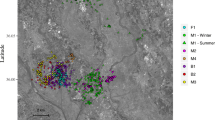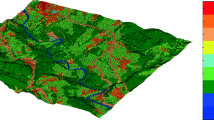Abstract
Triangulation by radiotelemetry is a method commonly used to estimate locations of wildlife. Despite the importance of the accuracy of resulting location estimates, there has been little development and comparison of alternative methods for point-location estimation for 25 years. Most methods assume that signal transmissions as they are received are consistent, but signal heterogeneity and fluxing is common. Using data from a beacon study, we determined that a subjective ranking of confidence in the accuracy of a signal was correlated with absolute bearing error. Using this factor and the distance from a telemetry station to the error triangle incenter, we developed an algorithm to place a weighted point-location estimate in relative proximity to each error triangle leg. We have termed this the weighted-incenter method. Despite previous findings that the major confidence ellipse axis of Lenth’s maximum likelihood estimator (MLE) correlated best to linear distance error, our beacon test data indicated that total bearing angle difference was the best single predictor of linear error with an optimal total angle of about 100°. The new and intuitive weighted-incenter method offered some improvement over previous methods such as the MLE estimator, but only with suboptimal angle bearings that may be common in field studies. By using a MATLAB function to produce data for site-specific regression analyses, one can determine which method should produce the more accurate point-location estimate for each triangulation observation. Further significance of this study for field biologists is discussed.





Similar content being viewed by others
References
Avey JT, Ballard WB, Wallace MC, Humphrey MH, Krausman PR, Harwell F, Fish EB (2003) Habitat relationships between sympatric mule and white-tailed deer. Southwest Nat 48:644–653
Balkenbush JA, Hallett DL (1988) An improved vehicle-mounted telemetry system. Wildl Soc Bull 16:65–67
Findholt SL, Johnson BK, McDonald LL, Kern JW, Ager A, Stussy RJ, Bryant LD (2002) Adjusting for radiotelemetry error to improve estimates of habitat use. General technical report PNW-GTR-555. United States Forest Service, Pacific Northwest Research Station, Portland, OR
Heffelfinger JR, Carpenter LH, Bender LC, Erickson GL, Kirchoff MD, Loft ER, Glasgow MW (2003) Ecoregional differences in population dynamics. In: deVos JC Jr, Conover MR, Headrick NE (eds) Mule deer conservation: issues and management strategies. Berryman Institute Press, Utah State University, Logan, UT, pp 63–91
Hupp JW, Ratti JT (1983) A test of radio telemetry triangulation accuracy in heterogeneous environments. In: Pincock DG (ed) Proceedings of the fourth wildlife biotelemetry conference. Applied Microelectronics Institute and Technical University of Nova Scotia, Halifax, Nova Scotia, pp 31–46
Kufeld RC, Bowden DC, Siperek JM Jr (1987) Evaluation of a telemetry system for measuring habitat usage in mountainous terrain. Northwest Sci 61:249–256
Larson MA (2001) Appendix A: a catalog of software to analyze radiotelemetry data. Millspaugh JJ, Marzluff JM (eds) Radio tracking and animal populations. Academic, San Diego, CA, pp 398–421
Lenth RV (1981) On finding the source of a signal. Technometrics 23:149–154
Millspaugh JJ, Marzluff JM (eds) (2001) Radio tracking and animal populations. Academic, San Diego, CA
Neter J, Kutner MH, Nachtsheim CJ, Wasserman W (1996) Applied linear statistical models, 4th edn. WCB/McGraw-Hill, Boston, MA
Pace RM III, Weeks HP Jr (1990) A nonlinear weighted least-squares estimator for radiotracking via triangulation. J Wildl Manage 54:304–410
Saltz D, Alkon PU (1985) A simple computer-aided method for estimating radio-location error. J Wildl Manage 49:664–668
Saltz D, White GC (1990) Comparison of different measures of error in simulated radio-telemetry locations. J Wildl Manage 54:169–174
Wallingford BD, Lancia RA (1991) Telemetry accuracy and a model for predicting telemetry error. Proc Annu Conf Southeast Assoc Fish Wildl Agencies 45:178–188
White GC, Garrott RA (1990) Analysis of wildlife radio-tracking data. Academic, San Diego, CA
Withey JC, Bloxton TD, Marzluff JM (2001) Effects of tagging and location error in wildlife radiotelemetry studies. In: Millspaugh JJ, Marzluff JM (eds) Radio tracking and animal populations. Academic, San Diego, CA, pp 45–75
Acknowledgements
We thank R. Strauss for being a proficient instructor of MATLAB and D. Butler, M. Butler, J. Millspaugh, and G. White for providing constructive criticism on an earlier draft of this manuscript. We thank the owners and operators of the ATA, Shannon, Weatherly, and McCloskey ranches for their continued support of wildlife research. Our MATLAB functions are located at http://www.rw.ttu.edu/haskell/. This is Texas Tech University College of Agricultural Science and Natural Resources technical publication T-9-1059. Experiments were in compliance with accepted standards in the USA.
Author information
Authors and Affiliations
Corresponding author
Additional information
Communicated by Paul R. Krausman
Rights and permissions
About this article
Cite this article
Haskell, S.P., Ballard, W.B. Accounting for radiotelemetry signal flux in triangulation point estimation. Eur J Wildl Res 53, 204–211 (2007). https://doi.org/10.1007/s10344-006-0076-9
Received:
Accepted:
Published:
Issue Date:
DOI: https://doi.org/10.1007/s10344-006-0076-9




